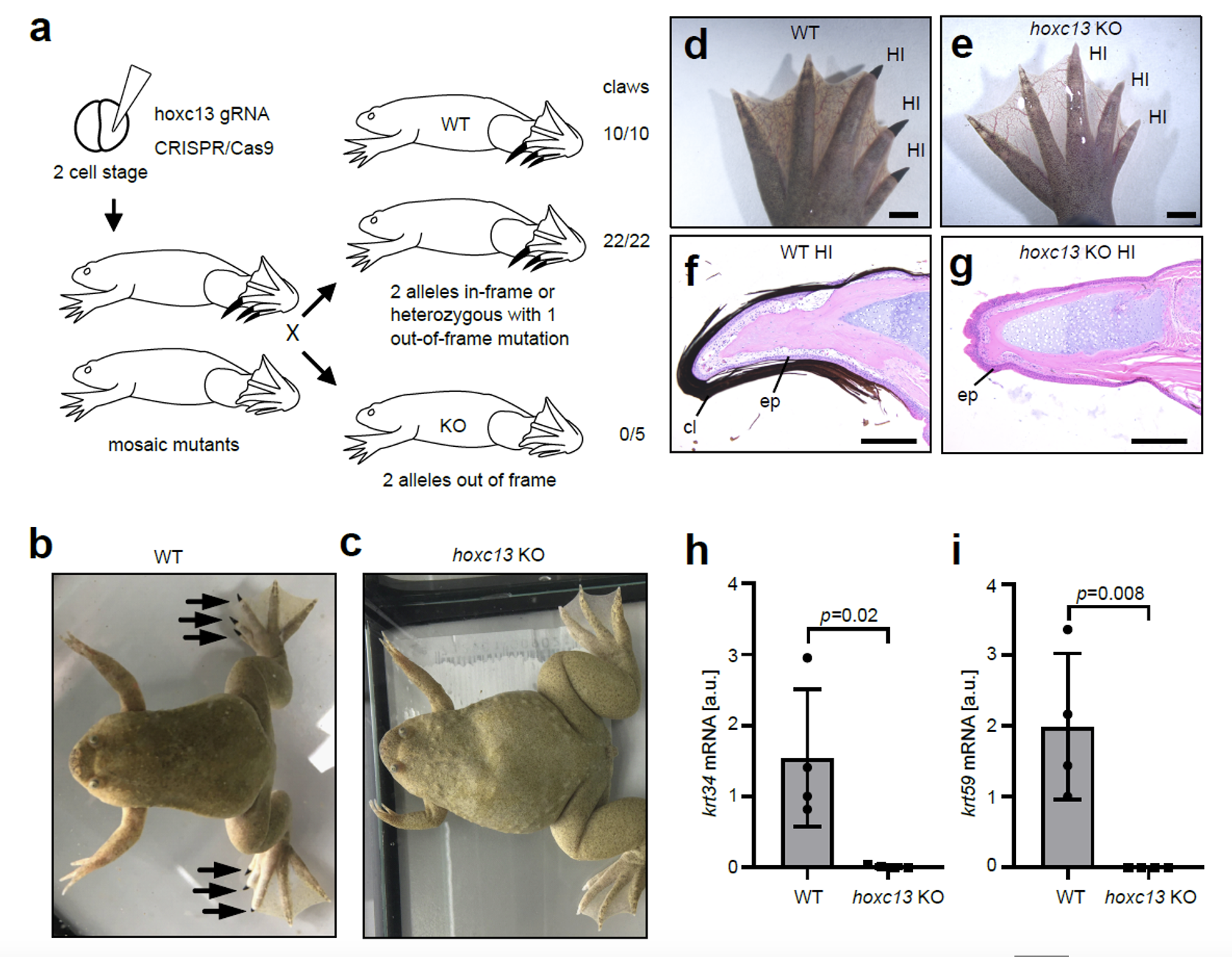Hoxc13 regulates claw formation in Xenopus
Evolutionary origin of Hoxc13-dependent skin appendages in amphibians
Carron M, Sachslehner AP, Cicekdal MB, Bruggeman I, Demuynck S, Golabi B, De Baere E, Declercq W, Tschachler E, Vleminckx K, Eckhart L.
Nat Commun 2024 Mar 18;151:2328. doi: 10.1038/s41467-024-46373-x.
Clawed frogs (Xenopus, meaning “strange foot”) differ from most other amphibians by featuring cornified claws on toes I-III of their hind limbs. Because of developmental and morphological differences, the claws of Xenopus frogs were thought to have evolved independently from claws of amniotes (reptiles and mammals). The claws of the latter are considered evolutionary precursors of hair because they are composed of proteins homologous to the keratins that build up hair. The new study from the laboratories of Kris Vleminckx, University of Ghent, Belgium, and Leopold Eckhart, Medical University of Vienna, Austria, provides surprising evidence for a common evolutionary origin of mammalian, reptilian and amphibian claws.
Carron et al. (Nature Communications 2024) report that homologs of mammalian hair keratins are expressed in the claws of X. tropicalis. The promoters of the genes encoding these keratins (Krt34 and Krt59) contain binding sites of the transcription factor Hoxc13, which is known to regulate the expression of mammalian hair keratins. CRISPR-Cas9-mediated inactivation of hoxc13 suppressed the expression of krt34 and krt59 and abolished the formation of claws in X. tropicalis (Figure 1). The results of the study by Carron et al. indicate that Hoxc13-dependent expression of hair keratin homologs evolved in a common ancestor of frogs and humans. This ancient genetic program provided the basis for the evolution of hair in mammals and for the evolution of specialized epithelial structures on the toes of amphibians, including the cornified claws of Xenopus frogs (Figure 2). In the latter, mutation of hoxc13 suffices to convert clawed frogs into clawless frogs.
Click here to view article at Nature Communications.
Click here to view article at Pubmed.
Click here to view article on Xenbase.
Interesting write-up at Science Alert: "Evolutionary Origins of Hair Identified in the Most Unlikely of Animals."
Abstract
Cornified skin appendages, such as hair and nails, are major evolutionary innovations of terrestrial vertebrates. Human hair and nails consist largely of special intermediate filament proteins, known as hair keratins, which are expressed under the control of the transcription factor Hoxc13. Here, we show that the cornified claws of Xenopus frogs contain homologs of hair keratins and the genes encoding these keratins are flanked by promoters in which binding sites of Hoxc13 are conserved. Furthermore, these keratins and Hoxc13 are co-expressed in the claw-forming epithelium of frog toe tips. Upon deletion of hoxc13, the expression of hair keratin homologs is abolished and the development of cornified claws is abrogated in X. tropicalis. These results indicate that Hoxc13-dependent expression of hair keratin homologs evolved already in stem tetrapods, presumably as a mechanism for protecting toe tips, and that this ancestral genetic program was coopted to the growth of hair in mammals.

Figure 4. hoxc13 knockout frogs lack claws and do not express hair keratins homologs. a Schematic depiction of hoxc13 knockout (KO) in X. tropicalis frogs. The number of animals bearing claws is shown on the right. Macroscopic appearance of a wildtype (WT) (b) and a KO (c) frog. Arrows point to claws. d-g Hind limb phenotypes (d, e) and histology (f, g) of hind limb inner (HI) toes of WT (d, f) and KO (e, g) frogs. Images in b-g are representative for at least 3 biological replicates. cl, claw; ep, epidermis. Scale bars: 2 mm (d, e), 200 µm (f, g). Quantitative RT-PCR analysis of krt34 (h) and krt59 (i) in HI toes of WT and KO. Statistics was calculated by unpaired two-tailed t-test. n=4 biological replicates for WT and KO. Age of the frogs: 7 months. a.u., arbitrary units. Bars and error bars indicate means and standard deviations, respectively.

Figure 6. Model for the evolutionary origin of Hoxc13 and hair keratin-dependent cornified skin appendages. The evolutionary changes in the expression pattern of Hoxc13 and the appearance of the regulatory link between Hoxc13 and “hair keratins” were inferred from data obtained in extant vertebrates and their known phylogeny. “Hair keratins” refers to human keratins KRT31-KRT40 and KRT81-KRT86 and their orthologs in other species. Red and blue shading mark sites of expression of Hoxc13 and hair keratin homologs, respectively.
Adapted with permission from Springer Nature on behalf of Nature Communications: Carron et al. (2024). Evolutionary origin of Hoxc13-dependent skin appendages in amphibians.Nat Commun 2024 Mar 18;151:2328. doi: 10.1038/s41467-024-46373-x.
This work is licensed under a Creative Commons Attribution 4.0 International License. The images or other third party material in this article are included in the article’s Creative Commons license, unless indicated otherwise in the credit line; if the material is not included under the Creative Commons license, users will need to obtain permission from the license holder to reproduce the material. To view a copy of this license, visit http://creativecommons.org/licenses/by/4.0/
Last Updated: 2024-03-28